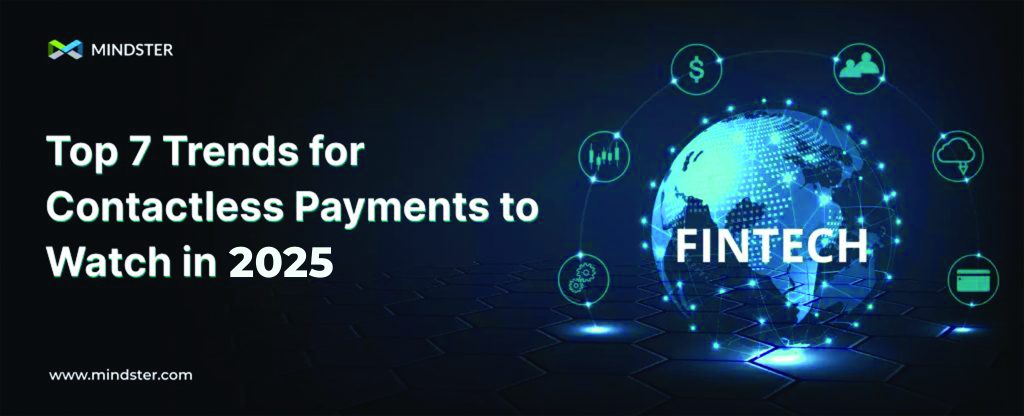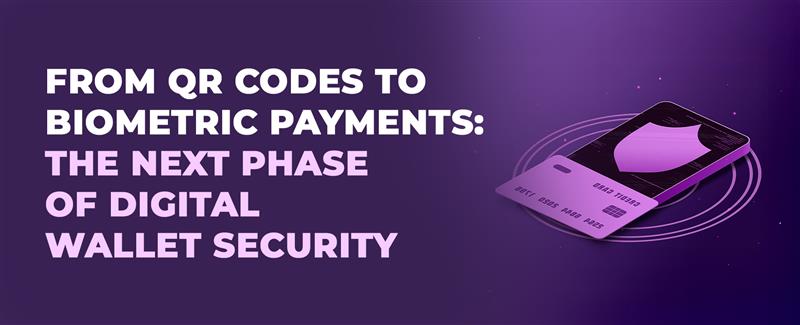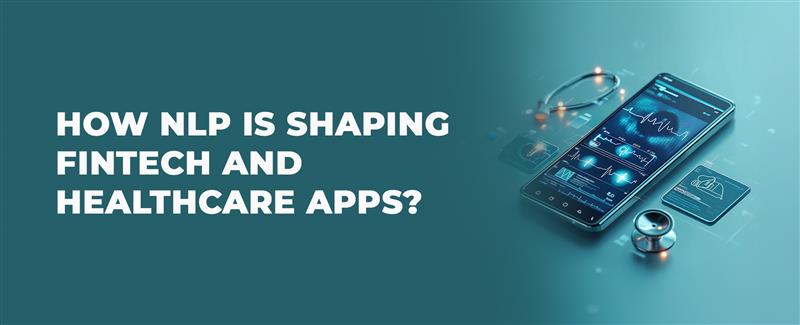Top 7 Trends for Contactless Payments to Watch in 2025
24 Jan 25 


Have you ever thought that the use of cash has decreased and contactless payments method have grown in popularity with the development of fintech apps?
Digital is no longer just another way to transfer money. Any company that handles money must be able to accommodate customers using computers, cell phones, and other devices while offering quick, secure payment options.
The digitization of payments significantly advanced the objective of achieving a simple, practical, quick, and safe payment mechanism. Throughout the last four to five years, there have been enormous advancements in digital payment systems, and more upgrades are on the horizon with fintech software development.
Customers’ payment methods have changed over the past several years due to actions they adopted during the pandemic, such as sticking around and altering their purchasing habits. Therefore, it’s crucial to consider how the payment environment will change as we move into another year so you can prepare and serve your consumers where they are.
Seven contactless payment trends are covered in this article to keep you competitive in 2025.
Top 7 Contactless Payment Trends in 2025
Mobile Wallets
One of the things that influences adoption is convenience. Consumers who primarily use their cell phones for online shopping may efficiently complete purchases with just a few clicks, thanks to mobile wallets. Mobile wallets offer a single payment option that customers can use on any channel because they can be used for both in-person and online transactions. This was made possible through fintech apps.
By 2025, 1 in 2 individuals worldwide will use a mobile wallet, according to the 2021 Mobile Wallets Study. With 45 percent of individuals utilizing this payment technology daily and 41 percent using it once weekly, China leads the globe. Although just 6% of individuals in the U.S. and Canada use mobile wallets daily, researchers predict growth across all geographies.
Peer-to-peer Payments (P2P)
P2P payments are ways to send and receive cash using mobile devices and a linked bank account or credit card. Examples include mobile online payments, near-field communication, SMS/direct carrier billing, and other P2P payment transaction types. These were possible with the integration of a fintech software development company.
In 2025, the P2P industry will produce more than $1 trillion in transaction volume, according to eMarketer. Peer-to-peer (P2P) payments have been around for a while, but as the market for digital payments expands, they are swiftly becoming more common and well-liked.
Worldwide, the P2P market is expanding more quickly due to rising smartphone adoption in the payments environment and the industry’s advancing digitization. This is the most notable trend in contactless payments, which will benefit the fintech industry in the long run. An Insider Intelligence report from September 2022 predicts that by 2030, the worldwide P2P market will be worth $9,135 billion (USD).
Online Payments
E-commerce is still expanding. E-commerce is expected to rise until 2026, following a record-breaking 31.8 percent growth in 2020. Consumers learned how easy it is to browse and purchase products online for delivery or in-store pickup during the COVID-19 epidemic. These behaviors will persist over time.
Online B2B payments are a developing trend, even though B2C competitors must meet the need for online payments. Companies moving forward with digital transformation initiatives are substituting digital invoicing and online payments for paper-based accounts receivable processes by properly integrating fintech software. Internet B2B payments give customers an easy way to pay while saving time, cutting expenses, and improving cash flow.
Loyalty Programs
Every smart merchant understands the value of customer loyalty, and loyalty programs are a terrific way to encourage and foster it. A loyalty program sometimes entails giving clients incentives for frequent engagement with that particular business, such as discounts, points, or awards. This might involve granting exclusive access to specific services or goods that aren’t accessible elsewhere or providing a percentage discount on future purchases.
The loyalty program heavily depends on the type of software used to give discounts or offers. Therefore, the fintech app development company relies on this, to provide fintech solutions through fintech software.
Some companies may use a tiered structure, where customers who spend more money receive more significant discounts. This provides additional incentive to return often, fostering confidence between consumers and businesses and establishing a tradition of high sales from devoted returning customers.
QR Codes
Although QR codes are nothing new, they gained popularity during the epidemic as companies sought to stop the virus from spreading through cash, tickets, and receipts.
Nowadays, QR codes are used for much more than improving the customer experience. They may also be used to start payments from payment providers and deliver information to consumers efficiently and cost-effectively.
Nowadays, QR codes may be found in various places, such as restaurants where patrons can scan a code to view the menu, place an order, and pay for their meal, and retailers where customers can scan a code to access offers. QR code generator tools make it easy for businesses to create and customize these codes for their specific needs.
Embedded Payments
Embedded payments allow clients to purchase and obtain credit in one place rather than visiting a physical bank to apply for credit and then make the transaction. In addition, customer-facing digital platforms integrate financial services into their offers via embedded finance technology.
Push-button payments are made by customers using embedded payments. That makes it possible for users to pay without having to move between applications, which expedites the payment settlement and checkout processes and offers an excellent user experience.
Whether you refer to them as super apps, embedded payments, or 4.X solutions, they are all part of the payment trend of decreasing friction and blending transactions into other experiences. In addition, developers are incorporating payment technologies into social networking, commerce, and specialty app platforms like WeChat. Over the next year, watch for additional applications and systems to integrate payments.
Buy Now, Pay Later (BNPL)
One of the most well-liked banking trends nowadays is the installment loan, known as the BNPL. The BNPL function, which stands for “Buy Now, Pay Later,” is frequently linked to a BNPL provider (such as Klarna or Affirm), a specific eCommerce site (such as Amazon or Grab), or a financial institution (a bank or card network).
Customers may purchase products like electronics, furniture, etc. and have the total cost paid to their credit or debit card through multiple equal payments. Recently, this financial market has developed, and in 2022, it will surpass $150 billion.
According to experts, the COVID-19 pandemic’s dramatic rise in FinTech development and digital technology use was the primary catalyst for BNPL adoption and expansion.
Generally, BNPL is a standard financial technology that brings fintech app development. Still, its use has increased as a result of the increased accessibility of BNPL programs through FinTech and mobile payment applications. As a result, the BNPL niche has enormous development potential and is anticipated to maintain the market’s rising trend.
BNPL is unquestionably a trend worth researching, whether you’re a merchant or a financial company. You can create your own BNPL program or incorporate one of the current alternatives into your product or service offering.
Wrapping Up
We can provide first-rate digital payment solutions if you’re prepared to proceed with your subsequent payment software project and adhere to the potential online banking trends. We have discussed the top seven trends that are currently followed in the contactless payments process in 2025.
We have a team of software specialists working on the mobile app development on hand to assist you in selecting the best technology stack, creating your fintech software from the ground up, and helping you every step of the way until a successful market launch. In addition, we help you integrate the best fintech software to make the payment process flexible and efficient.
We can assist you with creating a successful product of any complexity, whether it be a sophisticated trading platform or a digital wallet.
- Agentic AI1
- Android Development3
- Artificial Intelligence33
- Classified App3
- Custom App Development5
- Digital Transformation12
- Doctor Appointment Booking App14
- Dropshipping1
- Ecommerce Apps40
- Education Apps2
- Fintech-Apps37
- Fitness App4
- Flutter4
- Flutter Apps20
- Food Delivery App5
- Grocery App Development1
- Grocery Apps3
- Health Care10
- IoT2
- Loyalty Programs9
- Matrimony Apps1
- Microsoft1
- Mobile App Maintenance2
- Mobile Apps128
- Product Engineering6
- Progressive Web Apps1
- React Native Apps2
- Saas Application2
- Shopify9
- Software Development3
- Taxi Booking Apps7
- Truck Booking App5
- UI UX Design8
- Uncategorized6
- Web App Development1



















Comments